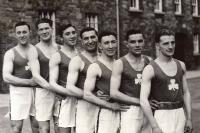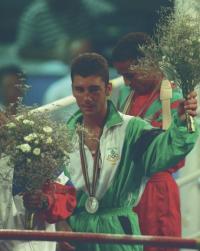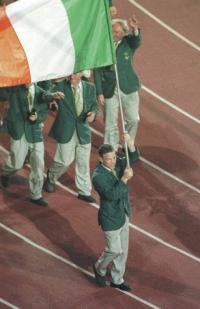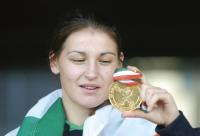Punching above our weight? Irish boxing and the Olympic Games
Published in 20th-century / Contemporary History, Features, Issue 4 (July/August 2012), Volume 20
The Irish boxing squad before departure to the 1948 London Olympics: (left to right) G. Ó Colmáin, H. O’Hagan, Peter Foran, Mick McKeon, Michael ‘Maxie’ McCullagh, Kevin Martin and W.E. Barnes. The last five all lost to eventual medal-winners, as did Willie Lenihan (not in the picture). (Irish Press)
Formal Irish participation in Olympic boxing had to wait until the Irish Amateur Boxing Association (IABA) re-formed in May 1920, following the hiatus of the Great War. Their first major all-Ireland tournament was at Dalymount Park in July 1920, and the first championship took place at the Abbey Theatre in February 1922. The organisation was headed up by two former champions—William McDonald and William Carroll. Army, police, civilian and university boxing sectors had representation on its general council.The make-up of early international teams reflected the encouragement given to the sport within the army. General Eoin O’Duffy, commissioner of the Civic Guards/Garda Síochána, was also a strong supporter. After the Civil War, the government set about achieving international recognition and an enhanced profile for the embryonic state, partly through sport. Despite British opposition, IOC permission was granted to the government to enter a team for the 1924 Paris games. Boxing was one of the front runners for selection despite a shortage of funds.
Paris, Amsterdam and Los Angeles
The 1924 Olympic boxing squad was dominated by army men and coached by recently appointed army instructor James ‘Tancy’ Lee. The Scotsman was a former British fly and featherweight champion and holder of a Lonsdale Belt. The 1924 team was not expected to achieve much. Nevertheless, Sergeant Patrick Dwyer, from Thurles, reached the welterweight semi-final, defeating boxers from England, Holland and Switzerland (KO) on his way, and losing out on a walk-over (through injury) for bronze. (Until 1952, losing semi-finalists had to box off for the single bronze medal on offer.) Featherweight Michael ‘Mossy’ Doyle lost out to the eventual gold medal-winner, ‘Jackie Fields’ (Jacob Finkelstein) of the USA, later a world professional champion. Middleweight champion William John ‘Boy’ Murphy, born in the Punjab, won by first-round KO against Eugene Nowak (Poland) and was then outpointed by Leslie Black (Canada) in the quarter-final. Murphy, a dispatch rider with the army, joined the Gardaí in 1926 and won a total of four senior titles.Sergeant Dwyer was appointed trainer to the 1928 Olympic team. This squad was better prepared. The selection comprised army (2), police (3) and civilians (3), all national champions. Boy Murphy, now at light-heavyweight, KO’ed his first opponent, José Montllor Pastor (Spain), in round one, and lost on points in the second round of the quarter-final, despite having floored Ernst Pistulla (Germany) twice. The German, a future European professional champion, won silver. Matt Flanagan suffered a first-round stoppage against Arturo Rodriguez Jurado (Argentina), who later won the heavyweight final, also by a first-round stoppage. P.J. Lenehan defeated European double medal-winner Arne Sande (Denmark) in his first bout, sending him to the canvas in round two. He subsequently lost to bronze medal-winner Ray Smillie (Canada). Middleweight Jack Chase also won his opener, against Alf Wilson (South Africa), losing out to bronze medallist Leonard Steyaert (Belgium). The most successful member was bantamweight Frank Traynor, who overcame Fuji Okamoto (Japan) and defeated Carmelo Robledo (Argentina)—gold medal-winner at featherweight at the 1932 LA Olympics—in the quarter-final. During the semi-final against the eventual champion, Vittorio Tamagnini (Italy), however, he was disqualified (‘for no cause’, according to pressman A.P. McWeeney at ringside) by referee Chandler (Great Britain), who had also disqualified Belfastman Corporal Myles McDonagh against Dutchman Ben Brel. Traynor was reinstated after a protest by the Irish Olympic Council but was not permitted to re-box the Italian. Cruelly, Harry Isaacs (South Africa) also pipped Traynor in the box-off for bronze. The Great Depression restricted the participation of European nations in the Los Angeles games of 1932. The IABA contributed £200 towards the expenses of the four Irish boxers selected: Ernie Smith, Pte John Flood, Constable James Magill and Garda James Murphy. Magill (25), from County Antrim, would go on to win three Irish middleweight titles, three ABA titles and three European police titles. Following Ulster Council statements regarding ‘the flag question’, however, he did not travel to Los Angeles. This highly unfortunate withdrawal benefited bantam champion Paddy Hughes, who was added to the team.Paddy Hughes and Pte John Flood both narrowly lost out to boxers from two of the most competitive boxing nations: Argentina (Pereyra) and South Africa (Barton). Another Argentinian, Robledo, defeated Ernie Smith on his way to the featherweight title. Garda Murphy outpointed local favourite Johnny Miler but was forced to concede through injury to silver medallist Gino Rossi (Italy) in the lightheavy semi-final. In a subsequent communication to the IABA from FIBA it was stated ‘that Garda Jim Murphy had been officially placed third in the cruiserweights at the Olympic Games’.
No all-Ireland teams at Berlin 1936
Irish boxing prospered under General W.R.E. Murphy’s leadership during the 1930s. The army, Garda, RUC, schools, universities and training colleges all had boxing instructors. Interprovincials, juvenile championships, club and schools tournaments were well supported. International squads arrived to compete against local selections and Irish teams travelled abroad. The 1930s also brought Fianna Fáil into government. An escalation of the ‘flag–anthem’ controversy into international sports resulted in the exclusion of, or boycotting by, all-Ireland teams from the 1936 Olympic Games in Berlin. Irish boxers, despite the support of FIBA, remained at home. Two French gold medallists at these games, Despeaux and Michelot, had previously been defeated by Irish boxers.The IABA successfully applied to stage the 1939 European Championships in the new National Stadium, Dublin. Ireland came second, behind Italy, in the medals table, Jimmy Ingle and Paddy Dowdall winning gold and Charlie Evenden bronze. The Stadium also hosted the first post-war European Championships, where Gearóid Ó Colmáin became heavyweight champion and Peter Maguire won silver at featherweight.
London 1948
The partitionist wrangle rumbled on into 1948, when 39 boxing nations, including Ireland, turned up for the resumed Olympics. W.E. Barnes of the Victory boxing club, Belfast, was the first selection on the Irish team. The well-prepared squad won a total of ten contests, Willie Lenihan, Kevin Martin, Michael ‘Maxie’ McCullagh, Peter Foran and Mick McKeon losing to eventual medal-winners. McCullagh lost a very tight decision against Svend Vad (Denmark) and Lenihan was well ahead going into the final round when he ran into a big right hand from Gianni Zuddas (Italy), whom he subsequently defeated the following January at the National Stadium.McKeon was the unluckiest of all. Having defeated Canadian and Iranian opponents, he outfought reigning European champion Aimé Escudie (France) in the quarter-final but lost a verdict later on the same day against John A. Wright (England). Dick Wilkes of the Irish Press, who quoted opinions from several foreign journalists, described the decision in favour of Wright as ‘one of the greatest pieces of boxing injustices I have ever seen’. McKeon was subsequently unable to box off for the bronze, on medical advice. At the IABA annual convention in October its president, Chief Supt P.J. Carroll, was scathing in his comments on the conduct of the IOC games committee and the organising committee, chaired by Lord Burghley, ‘both of which showed little regard for sporting principles and interests, not to speak of their own rules’. The following year Maxie McCullagh won the European lightweight title and best boxer award in Oslo, Norway, and featherweight Dave O’Connell claimed bronze.

Wayne McCullough—following his silver, and Michael Carruth’s gold, at Barcelona in 1992, boxing clubs nationwide received government assistance. (James Meehan/INPHO)
Helsinki and Melbourne: medals at last!
In 1952 John McNally (Belfast) brought home the first Irish boxing Olympic medal from Helsinki, battling through the bantamweight entries from 23 nations to reach the final. Here he lost to home favourite, Pentti Hämäläinen, on a majority decision. On his return to Belfast, Saturday 9 August, the popular Olympic medallist received a great reception. He was obliged, however, to remove his Irish blazer before receiving a presentation at the Ritz cinema.McNally’s historical achievement was emulated at the 1956 games, when the boxers brought home four medals—a silver and three bronze. The Helsinki team manager, Christy Murphy, was again appointed for Melbourne but took ill on the plane and was hospitalised for the duration of the games. British IOC representative Lord Burghley again challenged Ireland’s designation at the games, and scarcity of funds was once more apparent. Irish officials paid their own expenses. Special local collections were successful in ensuring the late selection of Fred Gilroy. Pat Sharkey (Donegal), a former Irish junior champion and Scottish senior champion, now working in Queensland, was nominated at heavyweight. Former Australian professional Snowy Sullivan, with little knowledge of the Irish boxers, assumed coaching duties. Martin Power, former Irish junior champion, working in Melbourne, assisted the team in a voluntary capacity.In spite of his late arrival, Gilroy knocked out double European finalist Boris Stepanov (USSR). He then defeated Mario Sitri (Italy) but was finally eliminated, on a Russian referee’s casting vote, in the semi-final against East Berliner Wolfgang Behrendt, who won gold. Fred Teidt’s controversial loss to Romanian Nicolae Linca in the welter final was widely derided. The renowned boxing author and editor of Ring magazine, Nat Fleischer, described the decision as ‘the most disgraceful decision I have ever witnessed’. Linca had also won a questionable verdict over European champion Nicky Gargano (GB) in his semi-final. John Caldwell (Belfast) and Tony ‘Socks’ Byrne (Drogheda) won bronze. Byrne subsequently defeated Olympic champion Corporal Dick McTaggart (GB) at the IABA vs ABA international at the Royal Albert Hall, London, sending him to the canvas in the second round. With Ronnie Delany’s victory in the 1500m final, a total of five medals from an entry of twelve was the best collective result in Irish Olympic history. At a post-Olympics reception held in the Dolphin Hotel, Lord Killanin, Olympic Council of Ireland (OCI) president and member of the IOC, remarked that the judging ‘was better than at Helsinki, but, unfortunately, we got one of the worst decisions’. He astutely recommended that in future ‘Ireland should not skimp on sending officials’ to the games.At the 1960 Rome Olympics the Irish team made little impact. The heroes of Melbourne—Teidt, Gilroy and Caldwell—had joined the professional ranks. Before the 1964 Tokyo Games Irish Times boxing specialist Peter Byrne questioned the wisdom of sending a team with ‘hopelessly out-moded boxing technique, lack of adequate training facilities and the absence of intensive collective training’ against Eastern European ‘professionals’. Nevertheless, Jim McCourt brought home a bronze medal—as did his fellow Belfastman Hugh Russell from Moscow in 1980. Nevertheless, despite fourteen European Championship bronze medals, Olympic pickings were slim in between.

Francis Barrett—here carrying the flag for Ireland at the opening ceremony of the 1996 Atlanta Olympics—has become a role model for other members of the Travelling community. (Billy Strickland/INPHO)
Reorganisation in the 1980s
At the end of the 1980s a coordinated and integrated coaching reform strategy was accepted by the IABA Central Council. A National Coaching Committee (NCC), composed of experienced coaches, rolled out and implemented this programme. Following a national coaches convention in 1989, a programme of workshop-seminars, a junior Olympic project, summer schools, input from sports science specialists and foreign experts and facility upgrades were developed. Heavyweight Cathal O’Grady won the European Junior title in 1995—an IABA first—and qualified for the 1996 Atlanta Olympics, as did Francis Barrett, an early summer school attendee. Barrett, who carried the flag at the opening ceremony, has become a role model for other members of the Travelling community. IABA current Olympians include John Joe Joyce and John Joe Nevin. The latter is the only Irish boxer to win medals at two World Championships. Joe Ward is a World Youth and European Senior champion.Following Paul Griffin’s 1991 European title win in Gothenburg—a first in 42 years—and the Olympic gold and silver results in Barcelona (1992), courtesy of Michael Carruth and Wayne McCullough, boxing clubs nationwide received government assistance. Within the past decade a customised unit, ‘High Performance’, resourced by the Irish Sports Council, has been established within the IABA, staffed by a small cadre of full-time coaches. The programme has now evolved into the creation of an élite squad of full-time boxers and their support staff, with a dedicated budget. The Beijing 2008 medals of Barnes, Sutherland and Egan and the international successes of J.J. Nevin and of London 2012 Olympian Katie Taylor represent the highlights of this dual project to date. HI

London 2012 Olympian Katie Taylor—one of the highlights of the dual IABA/Irish Sports Council project to date.
Breandán Ó Conaire is AIBA International Technical Officer and a former president of the IABA.
Further reading:
M. Carruth (with P. Byrne), Ring of gold (Dublin, 1992).L. Naughton & J. Watterson, Irish Olympians (Dublin, 1992).S. Ware, Laochra na hÉireann agus na Cluichí Oilimpeacha 1896–1996 (Baile Átha Cliath, 1996).
















